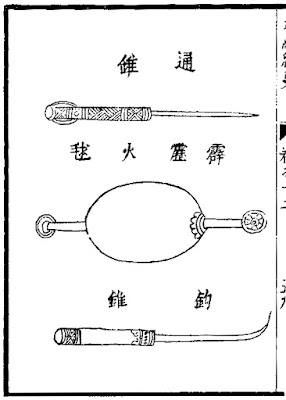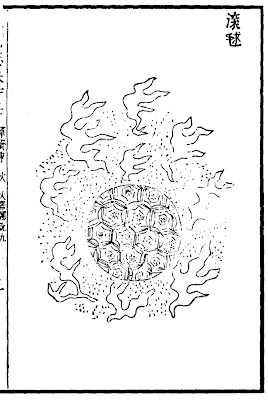Huo Qiu (火毬, lit. 'Fire ball') is a type of primitive incendiary bomb made of paper, bamboo basketry, or even clay. Developed during the eleventh century, Huo Qiu is one of the earliest gunpowder weapons in the world (along with gunpowder-based fire arrow and early rocket), predating even the fire lance.
At the time of its invention, Chinese people had yet to perfect the formula for explosive gunpowder, and fuse would not be invented for another century. As thus, Huo Qiu could only burn but not explode, and did not have a burning fuse. Instead, an iron awl was used to ignite the bomb (by poking a red hot awl through the ball). Huo Qiu was usually flung by a trebuchet, although some versions could be thrown by hand or launched from a sling.
 |
| A straight awl (top) and hook awl (bottom) used to ignite Huo Qiu. From 'Wu Jing Zong Yao (《武經總要》)'. |
Gun Qiu (滾毬, lit. 'Rolling ball')
 |
| Drawing of a Gun Qiu, from 'Wu Bei Zhi (《武備志》)'. |
Yin Huo Qiu (引火毬, lit. 'Fire-guiding ball')
 |
| Drawing of a Yin Huo Qiu, from 'Wu Bei Zhi (《武備志》)'. |
Ji Li Huo Qiu (蒺藜火毬, lit. 'Puncturevine fireball')
 |
| Drawing of a Ji Li Huo Qiu, from 'Wu Bei Zhi (《武備志》)'. |
Ji Li Huo Qiu is a variant of Huo Qiu that comes with three six-bladed knives as well as eight barbed caltrops on its surface. Presumably, the bomb will catch onto whatever surface it comes into contact with due to its barbed surface, or spread caltrops everywhere if it breaks on impact. It also produce poisonous smoke while burning to deter extraction.
Pi Li Huo Qiu (霹靂火毬, lit. 'Thunderclap fireball')
 |
| Drawing of a Pi Li Huo Qiu, from 'Wu Bei Zhi (《武備志》)'. |
It should not be confused with other weapons with similar names.
 |
| Drawing of a Feng Shan Che (風扇車), a hand-cranked fan used to blow the smoke produced by Pi Li Huo Qiu into the tunnel. |
Yan Qiu (煙毬, lit. 'Smoke ball')
 |
| Drawing of a Yan Qiu, from 'Wu Bei Zhi (《武備志》)'. |
Du Yao Yan Qiu (毒藥煙毬, lit. 'Poisonous smoke ball')
 |
| Drawing of a Du Yao Yan Qiu, from 'Wu Bei Zhi (《武備志》)'. |
Shen Huo Hun Yuan Qiu (神火混元毬, lit. 'Divine fire primordial ball')
 |
| Drawing of a Shen Huo Hun Yuan Qiu, from 'Wu Bei Zhi (《武備志》)'. |
Shao Zei Mi Mu Shen Huo Qiu (燒賊迷目神火毬, lit. 'Bandit-burning, eye-irritating divine fire ball')
 |
| Drawing of a Shao Zei Mi Mu Shen Huo Qiu, from 'Wu Bei Zhi (《武備志》)'. |
Shao Zei Mi Mu Shen Huo Qiu is very similar to Qun Feng Pao (羣蜂砲).
Tian Huo Qiu (天火毬, lit. 'Heavenly fire ball')
 |
| Drawing of a Tian Huo Qiu, from 'Wu Bei Zhi (《武備志》)'. |
Tian Huo Qiu is essentially a much deadlier version of Japanese metsubushi (目潰し) blinding egg, although unlike the Japanese version it is launched from a sling rather than being thrown by hand.
very cool weponry, I see were the japanese exploding trebuchet drawing in a ofsprey book took inspiration from the thunderclap fireball,showing their lack of research regarding asia once again.I recnetly found this picture from one of their qing era book ,and they depicted a miao in a nakhi armor.I can understand why they did this but they could equally have used the Qian rebellion leather laminar armor that is miao,sigh.
ReplyDeletecan i see this leather laminar armor ?
DeleteBy the way, which book does that Japanese thunderbomb picture come from?
DeleteI forgot to put the trebuchet image https://pin.it/6uj6cbkkovp54l
ReplyDeleteThis is the wrong miao image https://pin.it/xped4plrrkaw3x
Here is the real miao laminae http://www.davidleffman.com/zhang-xiumei-and-the-miao-war/
That Zhang Xiumei laminar armour is actually made of iron, as far as I can tell.
DeleteReally ? That's cool!
Deletehow are thoes plates hold together? i can see lower parts are holded with chain but cant see anything on torso
DeleteI think it's also chain, but I don't really know. Their is a detailed description in a website but it's in Chinese. So far I doubt that this armor is still intact, even tho the guy say it is. I really hate how much information is not available for people simply because things aren't publicly displayed in exposition or websites.
ReplyDeleteNot relevant to the article but I got two questions been meaning to ask you,what is the sword for the hero coming up in 'for Honor' base on, it seem to be the only one that took real life inspiration with the rest being fantasy base
ReplyDeletehttps://ubistatic19-a.akamaihd.net/resource/en-us/game/forhonor/fh-game/fh_y3_ka_logo_thumb_341970.jpg
And when did curvatures/ Sabres start to appear in China.
You mean the two-handed "straight katana" weapon? Honestly I am not sure what it is based on - it can be a passable representation of Miaodao if the last third of the blade is curved.
DeleteI think it looks really similar to a variation of 唐横刀
ReplyDeleteexample:
https://encrypted-tbn0.gstatic.com/images?q=tbn%3AANd9GcQE77RiNXHwNEUOqHr_lOgPRnu_Giv3mRAlTMDdU9d6nACRDKzP
The problem about so-called "Tang Dao" is that it is more or less the Chinese equivalent of Viking Horned Helmet or Japanese Ninjato, as most "replicas" on the market have dubious historicity (which ironically makes it perfect for games like For Honor). The replica you linked is slightly more accurate than most though.
DeleteFor "authentic" Tang sword, it's better to reference the few Kara-Tachi (which are almost certainly Tang period swords imported from China) stored in Shōsōin Treasure House of Japan.
Yeah I did meant the sword for the new Wu Lin warrior and if you want to look at Tang swords look at swords during the Tang Dynasty,blades like the Kara-Tachi were never meant to be used in combat it's more of a piece of jewelry then a weapon.
DeleteAnd 春秋戰國 THANK YOU, honestly some people use that as another way to bash the katana saying it's a glorified( or renamed) made with the worst steel ever, Tang dao, when the Katana didn't really start to exist until muromachi period and it's an evolution of the Tachi which is an evolution of the warabeita-to.
While the few Kara-Tachi in Japan aren't meant for battle, they do provide valuable insight to the design, steelmaking and decoration techniques of Tang period sword.
DeleteBTW, I should refer you to this invaluable article on katana steelworking:
http://gunbai-militaryhistory.blogspot.com/2019/01/iron-and-steel-technology-in-japanese.html